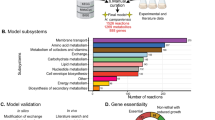Summary
Fifty-one methylotrophs were checked with respect to their ability of poly-β-hydroxybutyric acid (PHB) production from methanol. One of them, Pseudomonas sp. K, was chosen from its good growth on a minimum synthetic medium. Optimal temperature and pH for its growth were 30° C and 7.0, respectively. Concentrations of PO 3-4 and NH +4 in the medium should be kept at low levels. PHB formation was stimulated by deficiency of nutrient such as NH +4 , SO 2-4 , Mg2+, Fe2+ or Mn2+. Among them, nitrogen deficiency was chosen from its effectiveness and easiness for PHB accumulation.
The microorganism was cultivated to produce a large amount of poly-β-hydroxybutyric acid (PHB) from methanol by means of microcomputer-aided fully automatic fed-batch culture technique. During the cultivation, temperature, dissolved oxygen concentration (DO), and methanol concentration in the culture broth were maintained at 30° C 2.5±0.5 ppm and 0.5±0.2 g/l, respectively. Other nutrients, nitrogen source and mineral ions, were also controlled to maintain their initial concentrations in the medium during cell growth phase. When the high cell concentration was achieved (160 g/l), feedings of ammonia and minerals were stopped and only methanol was supplied successively to accumulate PHB. At 175 h, high concentration of PHB (136 g/l) was obtained and total cell concentration became 206 g/l. DO must be maintained above the critical level during the PHB formation phase, too. PHB yield from methanol (g PHB/g methanol) was 0.18 and the maximum PHB content reached 66% of dry weight. Solid PHB produced by the strain had the melting point of 176° C and the average molecular weight of 3.0x105.
Similar content being viewed by others
References
Braunegg G, Sonnleitner B, Lafferty RM (1978) A rapid gas chromatographic method for the determination of poly-β-hydroxybutyric acid in microbial biomass. Eur J Appl Microbiol Biotechnol 6:29–37
Dawes EA, Senior PJ (1973) The role and regulation of energy reserve polymers in microorganism. Adv Microbial Physiol 10:203–253
Emeruwa AC, Hawirko RZ (1973) Poly-β-hydroxybutyrate metabolism during growth and sporulation of Clostridium botulinum. J Bacteriol 116:989–993
Heinzle E, Lafferty RM (1980) A kinetic model for growth and synthesis of poly-β-hydroxybutyric acid (PHB) in Alcaligenes eutrophus H 16. Eur J Appl Microbiol Biotechnol 11:8–16
Lafferty RM, Heinzle E (1977) Extraction of a thermoplastic from bacteria. Chem Rundsch 30:14–16
Pawell KA, Collinson BA, Richardson KR (1981) Japanese Patent 117793
Repaske R, Mayer R (1976) Dense autotrophic cultures of Alcaligenes eutrophus. Appl Environ Microbiol 32:592–597
Schlegel HG, Gottschalk G, Bartha R (1961) Formation and utilization of poly-β-hydroxybutyric acid by knallgas bacteria (Hydrogenomonas). Nature, London, 191:463–465
Senior PJ, Dawes EA (1973) The regulation of poly-β-hydroxybutyrate metabolism in Azotobacter beijerinckii. Biochem J 134:225–238
Sonnleitner B, Heinzle E, Braunegg G, Lafferty RM (1979) Formal kinetics of poly-β-hydroxybutyric acid (PHB) production in Alcaligenes entrophus H 16 and Mycoplana rubra R 14 with respect to the dissolved oxygen tension in ammonium-limited batch cultures. Eur J Appl Microbiol Biotechnol 7:1–10
Suzuki T, Mori H, Yamane T, Shimizu S (1985) Automatic supplementation of minerals in fed-batch culture to high cell mass concentration. Biotechnol Bioeng 27:192–201
Taylor IJ, Anthony C (1976) Acetyl-CoA production and utilization during growth of the facultative methylotroph Pseudomonas AM 1 on ethanol, malonate and 3-hydroxybutyrate. J Gen Microbiol 95:134–145
Ward AC, Rowley BI, Dawes EA (1977) Effect of oxygen and nitrogen limitation on poly-β-hydroxybutyrate biosynthesis in ammonium-grown Azotobacter beijerinckii. J Gen Microbiol 102:61–68
Yamane T, Matsuda M, Sada E (1980), Application of porous Teflon tubing method to automatic fed-batch culture of microorganisms. II. Automatic constant-value control of fed substrate (ethanol) concentration in semibatch culture of yeast. Biotechnol Bioeng 23:2509–2524
Yano T, Mori H, Kobayashi T, Shimizu S (1980) Reusability of broth supernatant as medium. J Ferment Technol 58:259–266
Yano T, Kobayashi T, Shimizu S (1981a) Control system of dissolved oxygen concentration employing a microcomputer. J Ferment Technol 59:295–301
Yano T, Kobayashi T, Shimizu S (1981b) Abstract of Annual Meeting of the Society of Fermentation Technology, Japan, p.4
Author information
Authors and Affiliations
Rights and permissions
About this article
Cite this article
Suzuki, T., Yamane, T. & Shimizu, S. Mass production of poly-β-hydroxybutyric acid by fully automatic fed-batch culture of methylotroph. Appl Microbiol Biotechnol 23, 322–329 (1986). https://doi.org/10.1007/BF00257027
Received:
Revised:
Issue Date:
DOI: https://doi.org/10.1007/BF00257027




